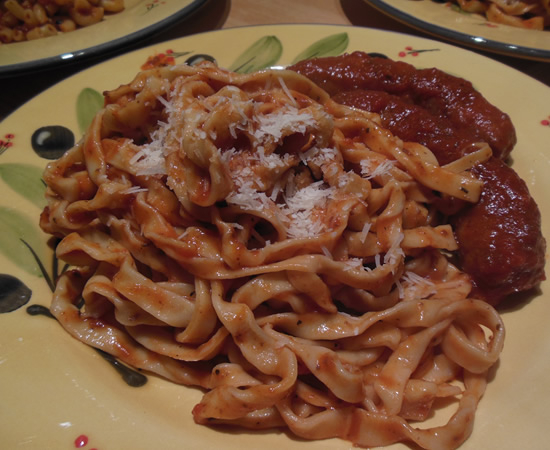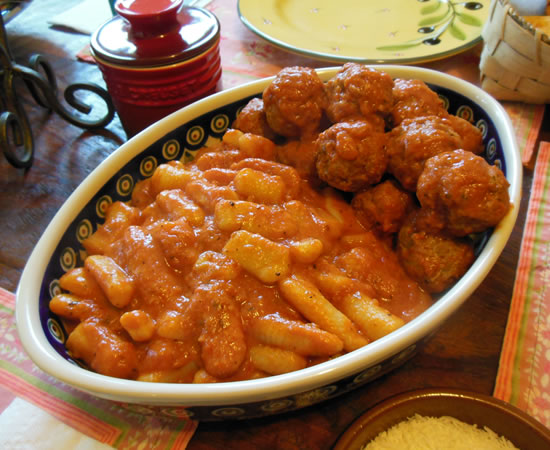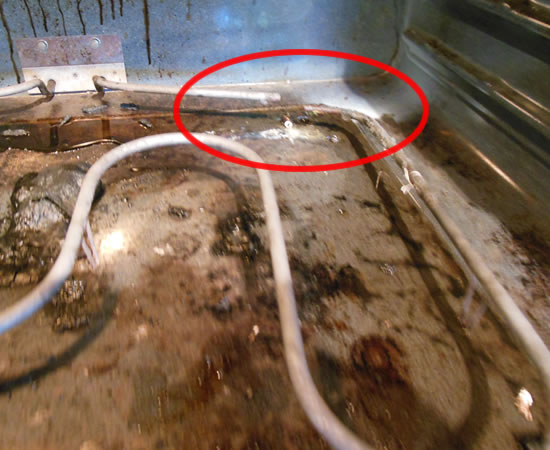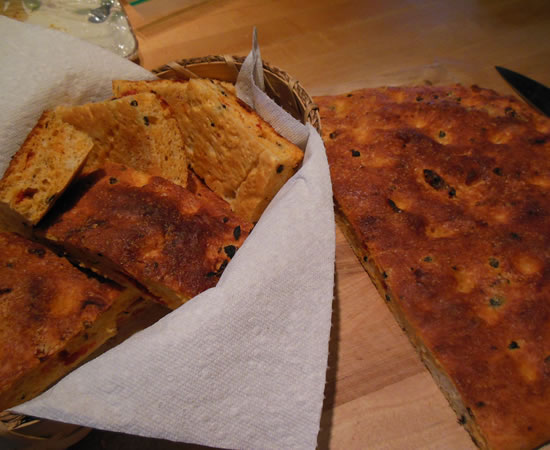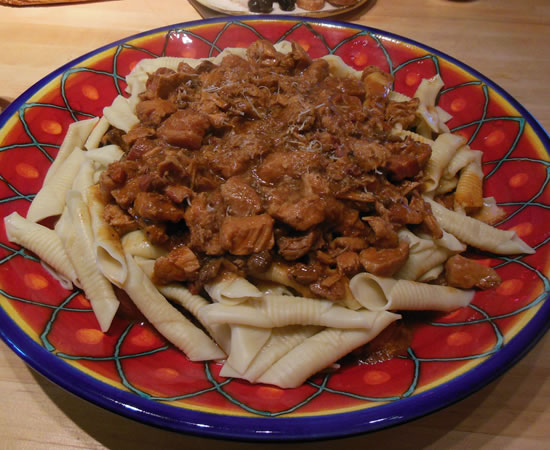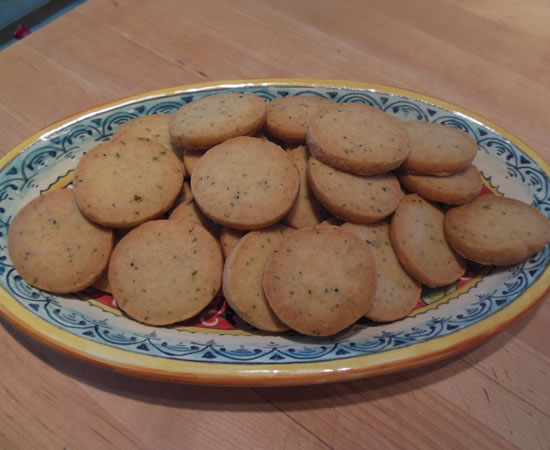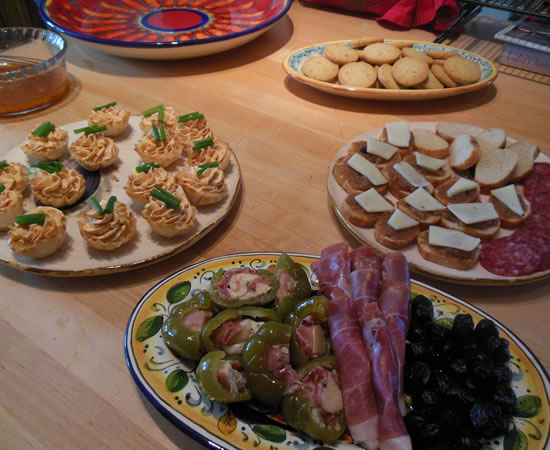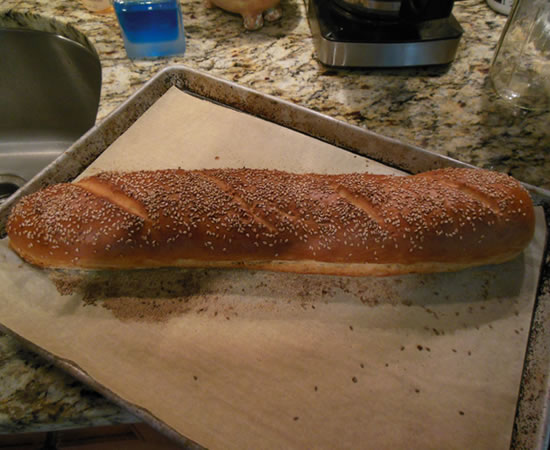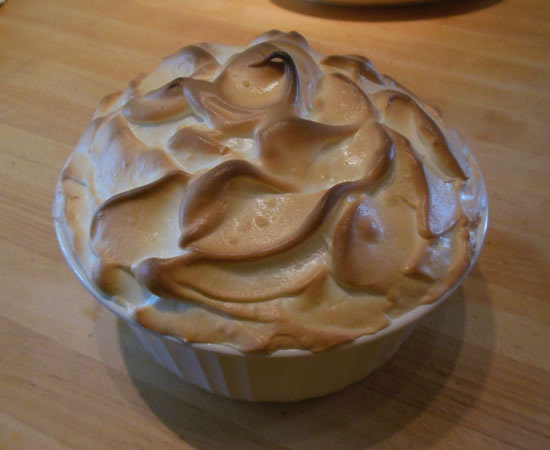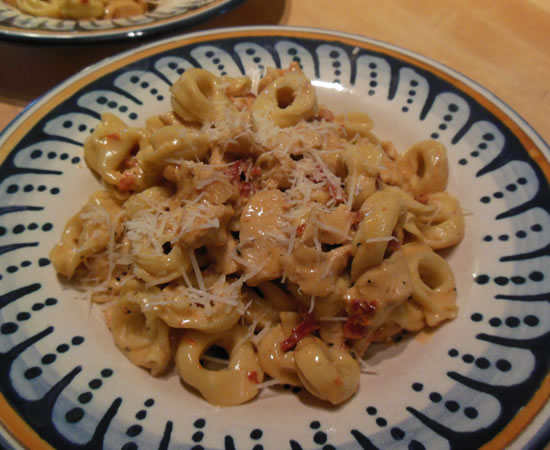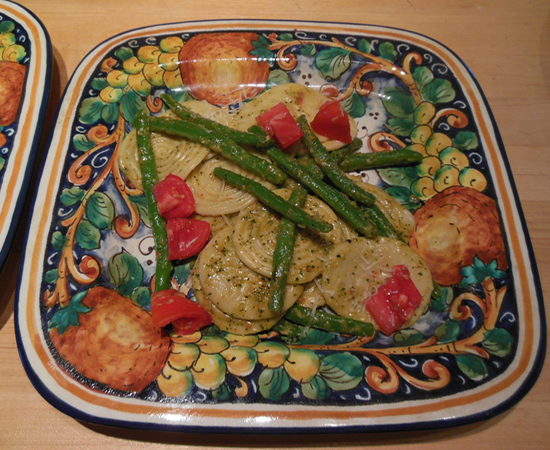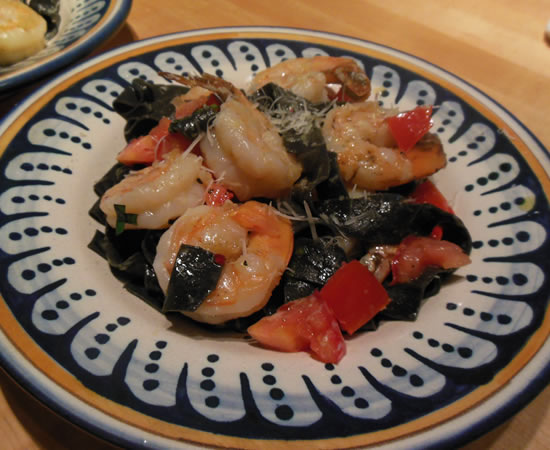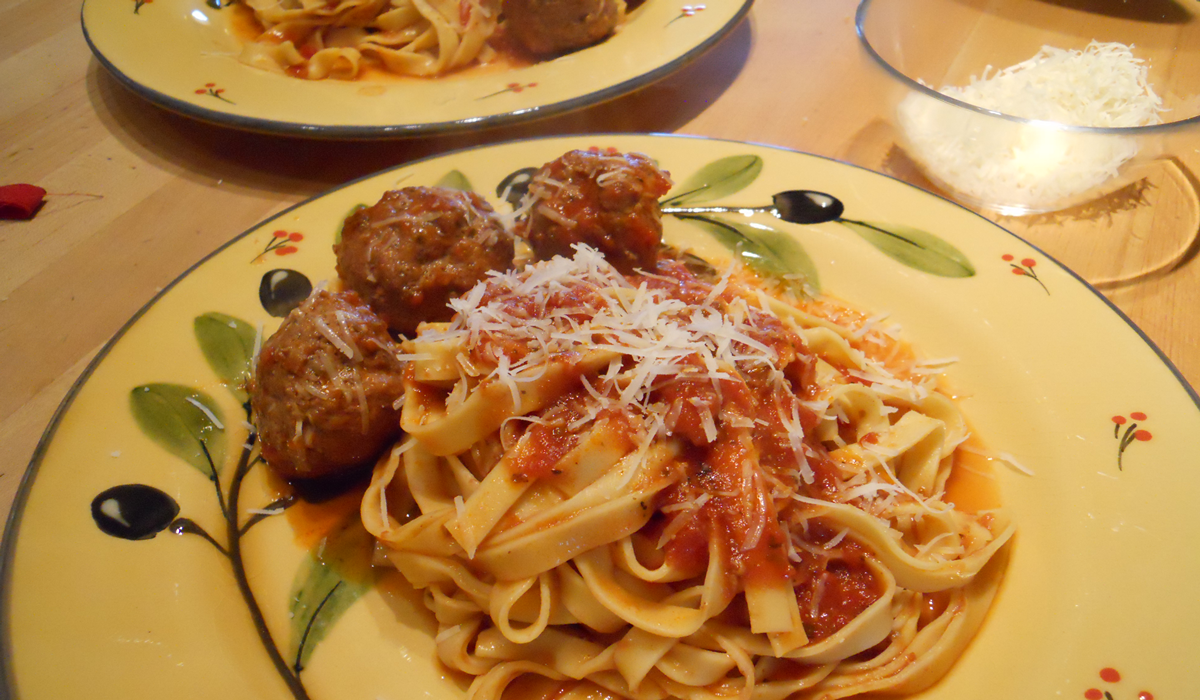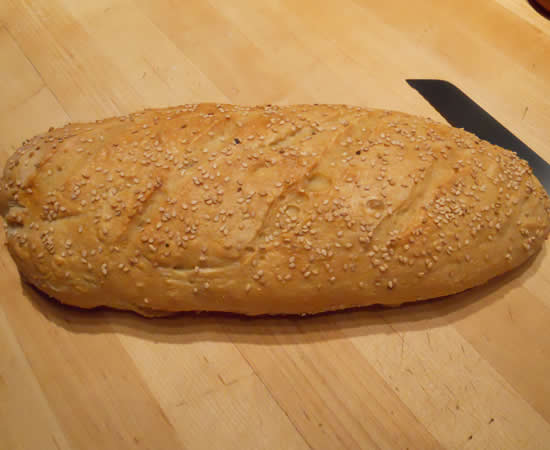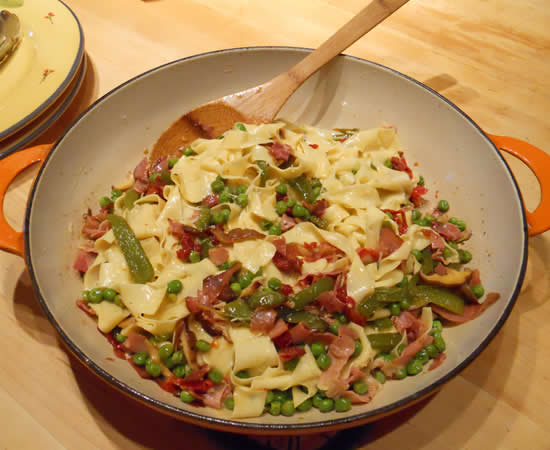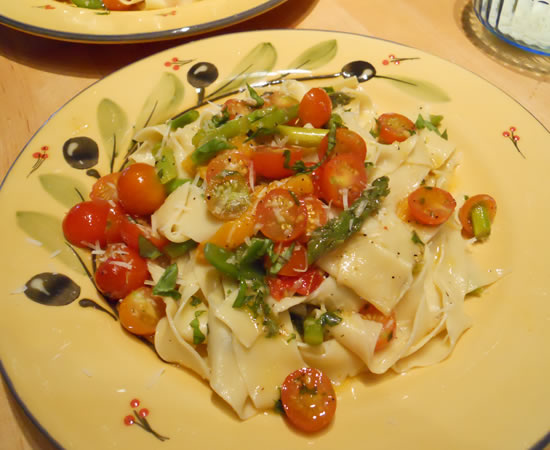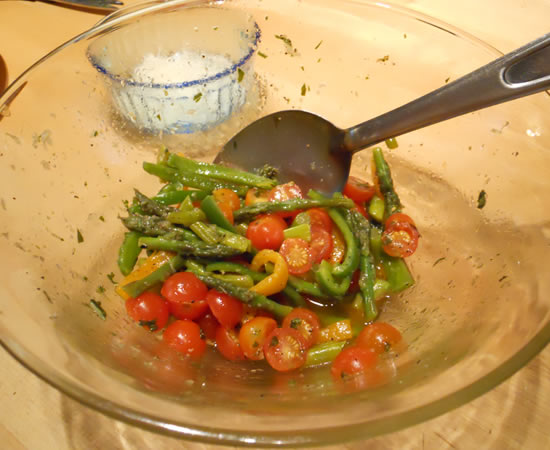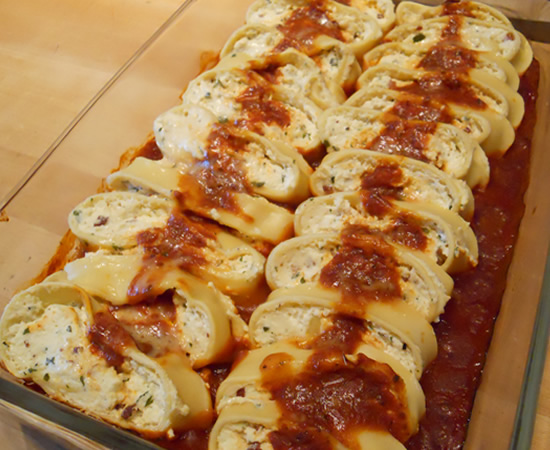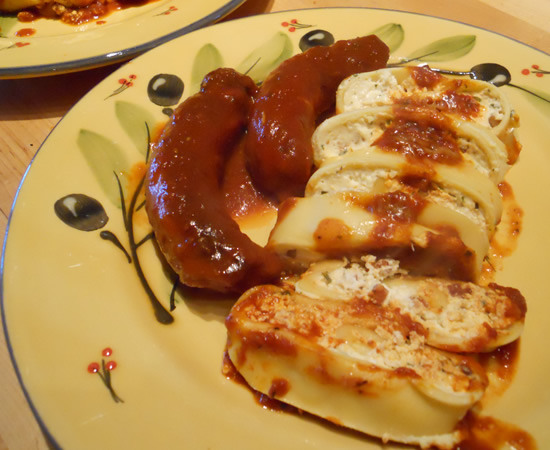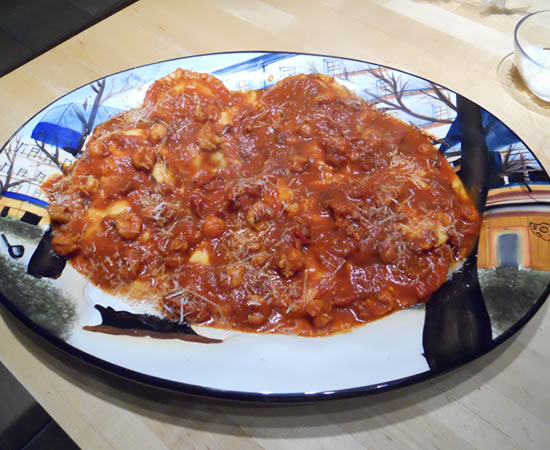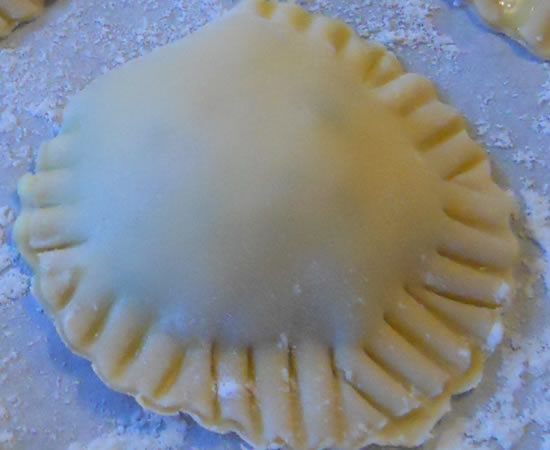Hand-Made Pasta
O.M.G. What a great pasta!
Tonight was a double-treat. Victor decided to cook and he decided to make a slightly different pasta than he usually makes. Years ago he bought me a pasta roller for my birthday or Christmas, and I've never used it. It wasn't out of the box 20 minutes when he made some pasta - and he's been making it ever since.
And trust me, I'm not arguing. His pasta is fan-freakin-tastic every time. I see no reason to try my hand at it when his is just so perfect. He makes it. I eat it.
Works for me.
This particular pasta is a bit more versatile than some - it could be rolled thick or thin and used as a fettuccine as we had tonight, or as a rolled dumpling for Chicken and Dumplings. His original fear was that it might be too eggy or like a typical egg noodle. It wasn't and isn't. I'm sure I'll be able to convince him to make it, again!
Fresh Egg Pasta
- 3 cups all-purpose flour
- 4 large eggs
- 1 tsp olive oil
- ½ tsp salt
Spoon 2 3/4 cups of the flour into the work bowl of a food processor fitted with the metal blade. Beat the eggs, olive oil and salt together in a small bowl until blended. With the motor running, pour the egg mixture into the processor. Process until it forms a rough and slightly sticky dough. If the mixture is too dry, drizzle in a very small amount of warm water and continue processing. Scrape the dough out of the work bowl onto a lightly floured counter.
Knead the dough with the heels of your hands until it is smooth, silky and elastic - 5 to 10 minutes of constant kneading.
Flour the work surface and your hands lightly any time the dough begins to stick while you’re kneading.
Roll the dough into a smooth ball and place in a small bowl. Cover and let the dough rest at least an hour before rolling and shaping.
The sauce was from the hoard in the freezer that he doctored up a bit.
My stomach is smiling!
Malloreddus, Focaccia, and a Broken Oven
I worked a rare Sunday shift, yesterday, and came home to fresh, homemade pasta and a focaccia just ready to go into the oven. How sweet it is.
Victor and I were standing in the kitchen talking right after the focaccia went into the oven when we both noticed a bright light in the oven. Little fires, flames, and flare-ups are not totally unusual in our ovens because we use them all the time and don't always clean them as often as we should.
But this wasn't a little flare-up. It was a bright white arc of heat on the element.It was immediately apparent that something was amiss, so I turned on the bottom oven to heat while we turned off the top. We have an arcing oven, but we also have a sheet of fresh focaccia that we are not letting go to waste. We have our priorities!
The nice thing about ovens is they are reasonably solid and insulated. A small flame inside of one is not going to burn down the house. The secret is to keep the flame inside. In this case there was no flame - just an arc of intense heat moving long the electric element like a lit fuse. Very bizarre.
I opened the oven door slowly - the ol' introduction of oxygen to a fire precaution - and moved the focaccia to the bottom oven, all the while fascinated by the glowing element. It had broken clean through and right past the break the arc was moving along the element just like a fuse. While it had a way to go before reaching the end of the element - and the electrical wires in back of the oven - it didn't really look like it would go out on its own. It needed a bit of help.
No, I do not have a fire extinguisher in the kitchen. Guilty as charged. But I do have a level head in emergencies, so I did what any son of a fireman would do. I used a sopping wet rag and tongs. It took a few minutes of gingerly playing with it - while Victor was across the room with the phone and 9-1 dialed - but I was able to cool it and put it out in just a couple of minutes. The focaccia came out of the bottom oven and we let everything cool completely. And then we made sure the circuits were off downstairs.
We then sat down to a fabulous dinner - homemade Malleddorus, homemade focaccia, and homemade meatballs and sauce. Victor added Boursin cheese to the sauce I had made and frozen. It came out great
Malloreddus are like a gnocci - just slightly-different ingredients, but they're similarly formed. Victor first got the recipe from la Cucina Italiana. It really is good.
Malloreddus
- Sea Salt
- 1 ¼ cups semolina flour
- ¾ cup unbleached all purpose flour
- Extra virgin olive oil
Gnocchi board or a table fork
Dissolve 1 tsp salt in ¾ cup warm water. In a large bowl whisk together semolina and all purpose flour; mound and form a well in the center.
Add water mixture and 2 tsp olive oil to the well. Using your hand or a fork, slowly incorporate flour from inside the rim of the well. Continue until liquid is absorbed, then knead in bowl until dough forms a complete mass (dough will be slightly sticky).
Transfer dough to a well floured work surface and knead, dusting with a bit more flour as needed just to keep dough from sticking to your hands, for 5 minutes. Wrap dough tightly in plastic wrap and let rest for 30 minutes.
Break off about 1/8 of the dough; tightly rewrap remaining dough. Roll dough into ½ inch cylinder, and cut into ¼ inch thick pieces. Pressing with your thumb, roll each piece on a gnocchi board (or down the back of a fork) to give it the characteristic ridges, and put on a floured baking sheet. Repeat with the remaining dough.
To cook fresh Malloreddus, bring a large pot of salted water to a bill. Add pasta and cook until tender, about 6 minutes after water returns to a boil. Drain, transfer to a large serving bowl and immediately toss with sauce and serve.
And then there was the focaccia that started all of this.
Focaccia
- 2 1/2 cups flour
- 1 pkg yeast dissolved in
- 1 cup warm water
- 1 tsp salt
- 1 tbsp sugar
- 2 tbsp olive oil
- 1/2 cup black olives, chopped
- 1/2 cup sun-dried tomatoes in oil, chopped
Knead all ingredients until smooth - about 10 minutes. Cover and let rise until doubled.
Punch down dough and spread out on lightly-greased baking sheet. Let rise again, about 30 minutes. Dimple top of dough with knuckles and place into a 425° oven oven about 20 minutes or until nicely-browned.
So after dinner, we were surveying the damage and decided we could go out and buy a new element, or we could go out and buy a new stainless steel oven. The new oven seems to be winning out. We need a new dishwasher, soon - the current one is rusting, the cook-top is a mess, and the handle to the over-the-stove microwave is super-glued in place.
The upside of using our kitchen every day is we eat some pretty awesome food. The downside is a lot of home appliances are not made to be used like commercial appliances. On the other hand, we have gotten 12 years of use out of the current stuff.
Last year, Victor got new granite counter tops for his birthday. It looks like this year, he's getting all new stainless steel appliances. His birthday is Friday. Perfect timing. We're going shopping.
Garganelli con Maiale in Guazetto
Our biannual dinner with Linda and David was a rousing success!
It's fun kinda going over the top now and again - and not easy cooking for a mere four people! My instincts are to make massive amounts of food for massive amounts of people. This turns into massive amounts of food for a mere four people.
We decided early on that we were going to do a strictly-Italian dinner because, well... we had to show off our fabulous hand-painted Italian dinnerware we had made for us on our recent trip to Italy. Yes. It is fun being insufferable now and again...
We also decided we would do a hand-made pasta because Victor has the pasta-making down to a science. He just flat-out makes fabulous pasta.
The sauce was to be a pheasant recipe from Lidia we made many times back in California when our next door neighbor would show up on our doorstep with pheasants he had just shot.
Damn, they were good.
Alas, it's not as easy to find pheasant here in suburbia. I actually ordered one from the local Wegmans and when I went to pick it up on Wednesday, it was really small and really expensive. I would have needed at least two of them for dinner and I just couldn't justify spending $30.00 each for them. They were very nice when I said "no thanks."
I came home empty-handed and Victor suggested pork. Brilliant, as we not only had cubed pork in the freezer, we also had a chunk of wild boar ventrèche. Ventrèche is marbled pork belly with a firm texture, similar to pancetta. It's rich, salty and very porky - the perfect addition to a dish that should have a bit of a gamy edge to it. Crisis averted and a new dish was born.
I made the sauce yesterday because it is definitely the type of dish that improves with an overnight stay in the 'fridge.
Garganelli con Maiale in Guazetto
- ½ cup dried porcini mushrooms
- 4 whole cloves
- 2 bay leaves
- 1 sprig fresh rosemary
- ¼ cup extra-virgin olive oil
- 2 1/2 lbs cubed pork
- freshly ground black pepper
- ½ cup chicken liver, trimmed and finely chopped
- 3 medium onions, chopped
- 8 oz ventrèche, thick-sliced
- 1 cup dry white wine
- 3 tablespoons tomato paste, plus 2 teaspoons
- 4 cups beef broth
- ½ cup Parmigiano-Reggiano, freshly grated, plus more for serving
Garganelli, made from basic egg pasta dough
Soak the porcini in 2 cups of warm water until softened, about 30 minutes. Drain the porcini, reserving the liquid. Rinse the mushrooms and chop them coarsely, discarding any tough bits. Strain the soaking liquid through a sieve lined with cheesecloth. Set the liquid and chopped mushrooms aside. Tie the cloves, bay leaves, and rosemary securely in a small square of cheesecloth.
In a large casserole heat the oil over high heat. Add the pork pieces and sprinkle lightly with salt and pepper. Cook until lightly browned, about 10 minutes. Remove the pork pieces.
Add the onions to the casserole, season them lightly with salt and pepper and cook until golden, about 5 minutes. Add the chicken livers and cook them, turning as necessary, until browned, about 4 minutes. Add the chopped porcini and cook, stirring, until they are dry, about 5 minutes. Add the wine and cook, stirring, until nearly evaporated, about 4 minutes. Stir in the tomato paste until the vegetables are coated. Add the reserved porcini liquid and about 1/2 cup of the beef broth and bring to a boil. Return the pork pieces to the pan and tuck the cheesecloth packet into the liquid. Cover the casserole partially and simmer gently until the liquid is reduced by about half, about 15 minutes. Continue simmering, adding beef broth 1/2 cup at a time and waiting until the liquid is reduced by half before adding more, until the pork is tender and the liquid is velvety, about 1 hour. Remove and discard the cheesecloth packet. Remove the meat and shred it coarsely. Return it to the sauce and reheat before serving.
And while I was at work, yesterday, Victor made the pasta.
Every one of those little buggers was cut and rolled by hand. This is where Victor excels over me. I do not have nearly the patience necessary to make this. The pasta is hand-made and rolled, then cut into squares, rolled around a little stick - Victor used a chop stick - and then rolled down a grooved board.
Each one.
Individually.
His pasta is excellent. Every time. I see no need to even try at this point.
Garganelli
- 3 cups "00" Italian flour - or all-purpose flour
- 4 large eggs
- ½ teaspoon salt
- 1 teaspoon extra-virgin olive oil
- warm water as needed
Place 3 cups of flour in a mound on a wooden surface, Make a well in the center of the mound. Beat the eggs, olive oil and salt together in a small bowl. Pour them into the well. With your finger, slowly incorporate the flour into the eggs until it is mixed.
Knead the remaining flour into the dough until a rough and slightly sticky dough is formed.
Knead the dough by gathering it into a compact ball, then pushing the ball away from you with the heels of your hands. Repeat the gathering and pushing motion several times, then press into the dough, first with the knuckles of one hand, then with the other, several times. Alternate between kneading and 'knuckling' the dough until it is smooth, silky and elastic-it pulls back into shape when you stretch it. The process will take about 10 minutes of constant kneading. Flour the work surface and your hands lightly any time the dough begins to stick while you're kneading.
Roll the dough into a smooth ball and place in a small bowl. Cover with plastic wrap. Let the dough rest at least one hour at room temperature, or up to 1 day in the refrigerator before rolling and shaping the pasta. If the dough has been refrigerated, let it stand at room temperature for about an hour before rolling and shaping.
To shape garganelli:
Run pasta through a pasta roller to about the second-thinnest setting. Cut into squares about 1-1 1/2". moisten one corner with a bit of water or egg and, from the opposite corner, roll around a wooden spoon handle or chopstick. Roll pasta down a grooved gnocchi board, pressing to create ridges and seal each piece of pasta.
Cook in boiling salted water about 6 minutes.
We had to start off with a few appetizers, of course. My first thought was to have an all-Italian cheese plate with some breads and crackers. Then I decided to make some crackers. Ina Garten has a great recipe for a cheese and thyme cracker - so off I went.
Parmesan Thyme Crackers
adapted from Ina Garten
- 1 cube unsalted butter, at room temperature
- 4 ounces freshly grated Parmesan cheese (about 1 cup)
- 1 teaspoon minced fresh thyme leaves
- 1/2 teaspoon kosher salt
- 1/2 teaspoon freshly ground black pepper
- 1 1/4 cups all-purpose flour
Cream the butter in mixer fitted with paddle attachment for 1 minute. Slowly add the Parmesan, thyme, salt, and pepper and mix well. With the mixer still on low, add the flour and combine until the mixture is in large crumbles, about 1 minute. If the dough is too dry, add 1 teaspoon water.
Dump the dough onto a floured board, press it into a ball, and roll into a 9-inch log. Wrap in plastic and refrigerate for at least 30 minutes or for up to 4 days.
Meanwhile, preheat the oven to 350°. Cut the log into 3/8-inch-thick rounds with a small, sharp knife and place them on a sheet pan lined with parchment paper. Bake for 22 minutes, until very lightly browned. Cool and serve at room temperature.
The crackers came out so good I decided adding cheese with them was overkill.
And then there was fig and onion on baguette with Italian truffle cheese, roasted red pepper cream cheese in filo cups, hot pepper shooters, prosciutto, salami, oil-cured olives, and a hot hors d'oeuvre made with thinly-rolled bread dough topped with salami, sauteed fennel, and gorgonzola cheese, and then topped with another thin sheet of dough and baked at 400° for about 15 minutes. Alas, I didn't get a picture of it.
Fresh-baked bread, of course. I made a batch of James Beard's Continental Bread.
James Beard French-Style Bread
- 1 package active dry yeast
- 2 tsp sugar
- 2 cups warm water (100° to 115°, approximately)
- 2 tsp salt
- 5 cups bread flour
- 3 tablespoons yellow cornmeal
- 1 egg white, mixed with 1 tablespoon cold water
- sesame seeds
Directions
Combine the yeast with sugar and warm water in a large bowl and allow to proof. Mix the salt with the flour and add to the yeast mixture, a cup at a time, until you have a stiff dough. Remove to a lightly floured board and knead until no longer sticky, about 10 minutes, adding flour as necessary. Place in a buttered bowl and turn to coat the surface with butter. Cover and let rise in a warm place until doubled in bulk, 1½ to 2 hours.
Punch down the dough. Turn out on a floured board and shape into long, French bread-style loaves. Place on a baking sheet that has been sprinkled with the cornmeal but not buttered. Slash the tops of the loaves diagonally in two or three places, and brush with the egg wash and sprinkle with sesame seeds. Place in a cold oven, set the temperature at 400°, and bake 35 minutes, or until well browned and hollow sounding when the top is rapped.
I actually just made one loaf and used the rest of the dough for the appetizer.
And then we had dessert...
Zuppa Inglese. It translates to "English Soup." We first had it at a great restaurant in Florence. I've now made it twice and this time was the best. I think I finally have it down.
Zuppa Inglese
Sponge cake:
- 2 tbsp unsalted butter, melted
- 1 cup sifted cake flour
- 1/2 cup sugar
- 1/8 tsp salt
- 4 large eggs, at room temperature
- 1 tsp pure vanilla extract
Pour the melted butter into a 1-quart bowl; reserve. Return the sifted flour to the sifter or sieve and add 1 tbsp of the sugar and the salt; sift onto a piece of waxed paper and set aside.
Put the eggs and the remaining sugar into the bowl of a heavy-duty mixer (or work with a hand-held mixer). Holding the whisk attachment from the mixer in your hand, beat the mixture to blend the ingredients. With the bowl and whisk attachment in place, whip the mixture on medium speed until it is airy, pale, and tripled in volume, like softly whipped cream, 4 to 5 minutes. You’ll know that the eggs are properly whipped when you lift the whisk and the mixture falls back into the bowl in a ribbon that rests on the surface for about 10 seconds. If the ribbon immediately sinks into the mixture, continue whipping for a few more minutes. Pour in the vanilla extract during the last moments of whipping.
Detach the bowl from the mixer. Sprinkle about one third of the sifted flour mixture over the batter. Fold in the flour with a rubber spatula, stopping as soon as the flour is incorporated. Fold in the rest of the flour in 2 more additions.
Gently spoon about 1 cup of the batter into the bowl with the melted butter and fold the butter in with the rubber spatula. Fold this mixture into the batter in the mixer bowl. (This is the point at which the batter is at its most fragile, so fold gingerly.) The batter should be poured into a prepared pan and baked immediately.
Bake at 350° about 25-27 minutes or until cake springs back when lightly touched and just begins to pull away from the sides of the pan.
Cool in pan about 10 minutes then remove, cooling right-side up on cooling rack.
Sugar Syrup:
- 1 cup sugar
- 1 cup water
- 2 tbsp limoncello
Mix ingredients. Bring to boil in small saucepan and boil about 1 minute. Cool and set aside.
Pastry Cream
- 2 cups whole milk
- Grated zest of 1 lemon
- 1 egg
- 2 egg yolks
- ⅓ cup sugar
- ⅓ cup unbleached all-purpose flour
- 1 teaspoon vanilla extract
Bring the milk and lemon zest to just below the boiling point; remove from the heat. In a medium bowl, beat the egg, egg yolks, and sugar until creamy. Add the flour and vanilla as you beat with a whisk, then slowly beat in the hot milk, still whisking. Pour the mixture into the pot in which you heated the milk. Cook over medium heat, stirring, until thick, about 5 minutes. Transfer to a bowl, cover, and refrigerate 2 hours.
Meringue
- 4 egg whites
- 1/2 cup sugar
Whip egg whites. Slowly add sugar and continue whipping until firm peaks are formed.
To assemble
Slice cake horizontally into three layers. Cut to snugly fit bottom of baking dish. Liberally douse with sugar syrup. Cover with half the pastry cream. Place second layer of cake on top, press down, again liberally douse with sugar syrup and the rest of the pastry cream. Top with final layer of cake.
Completely seal top of dish with meringue. Place in 450° oven about 5 minutes to brown meringue.
Serve at room temperature.
It's just spooned out onto the plate. It doesn't necessarily make the most fabulous presentation, but no one notices after the first bite!
A fun meal with fun friends. The perfect way to end the year.
Cheese Tortellini with Chicken
I had a hankerin' for pasta but had taken a couple of chicken breasts out of the freezer. The only sensible thing to do in a situation like that is to take the chicken and make a nice, creamy sauce to go with the pasta.
And being the ever-sensible person that I am, that's exactly what I did!
Yes, sensibility abounds in the Dineen/Martorano household. Well... at least it does in my mind - and that's really the only thing that matters, right?!? Right.
So... donning my sensibility cap, I started out.
Into the pot went the tortellini. They take about 8 minutes to cook.
I cut up the chicken into small cubes - maybe 1/2" - and quickly sauteed them in a drizzle of olive oil. I minced a garlic clove and added that to the skillet, and then chopped a couple tablespoons of sun-dried tomatoes in oil and added them.
I then added about 3/4 cup of heavy cream and a pinch of salt and pepper. I let it boil and thicken while I drained the pasta.
I added a hefty handful of freshly-grated pecorino romano, stirred it in, and then added the tortellini.
Simplicity.
It definitely came out good. The sauce thickened nicely and the tomato and cheese - and garlic - added a nice bite.
And it took less than 15 minutes to get it on the table!
So sensible.
Corzetti with Pesto and Green Beans
The Pasta Issue from La Cucina Italiana magazine has arrived. Victor has been poring over it looking for fun things to make - last year's issue didn't really do it for him - and found quite few that he likes. We're going to be eating well! The first thing he did was send away for a corzetti stamp from Fante's. The stamps date from the Renaissance courts of Liguria in northern coastal Italy around Genoa. Coin-shaped corzetti pasta would be stamped with coats of arms and symbols representing holidays. While the stamps would show ones prominence at court, they also have a practical purpose - the textures help capture the flavors of the sauce.
The recipe for the dough is a bit different than the one he normally makes. This one called for a 1/2 cup of water. It made for a bit of a stickier dough than usual, but he made up for it with flour for rolling. Oh... and we just happen to have Italian "00" flour. If you don't, use all-purpose.
Fresh Corzetti
- 2 cups "00" flour - or all-purpose flour
- 1/8 tsp salt
- 2 large egg yolks
- 1/2 cup tepid water
Mix together flour and salt on counter. Make a well and add the yolks and water. Using your finger (or a fork) and slowly incorporate the egg, water, and flour. Use a dough scraper to gather the dough up and form into a ball. Sprinkle more flour on the board and knead the dough until it is smooth - about 5 minutes. Cover dough and let rest about 30 minutes. This is actually an important step. During the resting period, starch molecules in the flour are absorbing the liquid in the dough. This gives the dough a thicker, more viscous consistency. The gluten is also relaxing which helps create a thin and uniform structure to the dough. And because the gluten had time to relax, the texture is delicate instead of chewy.
Divide dough into 4 pieces. Roll pasta through machine starting at widest setting about 4 times, folding and turning dough each time, until it is smooth and the width of the machine. Continue feeding dough though machine, decreasing the setting one notch each time, until about 1 1/2 millimeters thick - Victor went to setting three.
Dust pasta with flour and then, using corzetti cutter, cut out rounds. When rounds are cut, use the corzetti stamp to stamp each coin individually.
Cook pasta in boiling water about 6-7 minutes. Drain and immediately mix with sauce.
The pasta was time-consuming to make, but - WOW - what a great flavor and texture! Looking at the size, they should have been heavy - but they were really light with a good tooth and great texture.
The magazine recipe called for a sauce with scallops. Victor decided we had so much basil we needed a pesto sauce, instead. Naturally, he was right!
Pesto with Sun Dried Tomatoes
- 1 cup pine nuts
- 4 cups basil leaves
- 3 garlic cloves
- 1/2 cup grated pecorino romano cheese
- 1/4 cup sun dried tomatoes in oil
- 1/2 cup olive oil
- S&P to taste
Toast pine nuts. Cool. Add basil, pine nuts, and garlic to food processor. Mix a bit and then add cheese, sun dried tomatoes, and a pinch of salt and pepper. Mix well. With machine running, slowly add olive oil. Check for seasonings and ad S&P, as desired.
To pull the dish together...
Cook pasta and drain. Cook green beans until barely done. (Cook with the pasta and save a pot.) Add pesto to skillet. Add pasta and green beans, along with a bit of pasta cooking water, and gently mix.
Serve with additional grated cheese and chopped fresh tomatoes.
This rocked on every level! The pasta was substantial but surprisingly light. The sauce just screamed fresh-from-the-garden-goodness. We not only cleaned our plates, but really cleaned them with slices of Italian bread to get every drop of sauce. They were almost clean enough to put back in the cupboard!
This one is a keeper.
Squid Ink and Shrimp
It's so much fun to come home on Saturday to whatever delight Victor has come up with. It just never fails to delight my gastronomic senses. And it pretty much delights the rest of my senses, as well.
Tonight I walked into the house to the smell of fresh-baked focaccia and squid ink pasta drying. Ya shoulda seen the smile on my face!
Victor has the pasta-making down to a complete science. I will probably never make homemade pasta again in my life. His is perfect.
For the squid ink pasta, he just takes his basic recipe and adds a drop or two of the ink. We keep it in the freezer - a little goes a long way and it doesn't freeze solid so it's always at the ready! This is enough for two good portions. Double or more for however many you're cooking for.
Victor's Pasta
- 1 cup unbleached all-purpose flour
- 1 large egg
- 1 large egg yolk
- 1/8 teaspoon squid ink
- up to 1 teaspoon water, if necessary
Instructions
On a clean work surface, mound flour and form a well in the center. Add egg and egg yolk to the well. Using a fork, gently break up yolks and slowly incorporate flour from inside rim of well. Continue until liquid is absorbed, then knead for 10 minutes. Wrap dough tightly in plastic and let rest for 30 minutes.
Divide dough into 3 pieces. Cover 2 pieces with plastic wrap. Flatten remaining dough piece so that it will fit through the rollers of a pasta machine.
Set rollers of pasta machine at the widest setting, then feed pasta through rollers 3 or 4 times, folding and turning pasta until it is smooth and the width of the machine.
Roll pasta through machine, decreasing the setting, one notch at a time (do not fold or turn pasta), until pasta sheet is scant 1/16 inch thick.
Cut sheet in half widthwise; dust both sides of sheets with flour. Layer sheets between floured pieces of parchment or wax paper. Cover with paper and repeat with remaining dough.
With the short end of 1 pasta sheet facing you, loosely fold up sheet, folding sheet over two or three times from short ends toward the center. With a large chefs knife, cut folded sheet into ribbons, a scant 1/4 inch wide. Unroll strips and lightly dust with flour; spread on a lightly floured baking sheet. Repeat with remaining pasta sheets.
To cook the tagliatelle, bring a large pot of salted water to a boil. Add pasta and cook until tender, about 3 minutes. Drain pasta, transfer to a large serving bowl and toss with sauce.
For the sauce, he sauteed garlic in olive oil and butter. In went jumbo shrimp and he cooked until almost done. He added a good squeeze of lemon juice, zest from half a lemon, a healthy pinch of red pepper flakes, and about a quarter-cup of grated grana padano. He took it off the stove and added one chopped tomato and then stirred in the cooked pasta.
It rocked. Conversation consisted of "Umm." "This is great." "Mmm." "Burp." "This is great."
We both cleaned our plates.
Adapted from Better Homes and Gardens.
Focaccia
Ingredients
- 3 cups all-purpose flour
- 1 pkg. active dry yeast
- 1/2 tsp. salt
- 1 cup warm water (110°)
- 2 Tbsp. olive oil
Directions
- In a large mixing bowl combine the flour, the yeast, and salt; add warm water and oil. Beat with an electric mixer on low speed for 30 seconds, scraping bowl constantly.
- With dough hook in place, knead to make a moderately stiff dough that is smooth and elastic (6 to 8 minutes total). Lightly grease a large bowl; place dough in bowl and cover with a towel. Let dough rise in a warm place until double in size (30 minutes).
- Punch dough down. Turn dough out onto a lightly floured surface. Roll into a 16×12-inch rectangle. Place in a greased 16x12x1-inch baking pan. Let rise 20 minutes.
- Top with toppings of choice and bake at 375° about 25 minutes.
This is another great no-fail recipe.
And there's grilled peaches for dessert!
Sunday Dinner
Sunday Dinner. What a great tradition. It was usually a big dinner day for us when we were kids growing up - especially if Pop was home from the firehouse. It still amazes me how we all fit in that dining room around that table. It wasn't the multi-generational Italian Sunday Dinners of Victor's youth, however.
Ours were pretty much confined to our immediate family. Once in awhile it would include our great-aunts - or us at their home. His was the open door, everyone and their brother showed up. The Italians definitely ate more.
So it's really no surprise that if Victor is cooking, Sunday Dinner takes on that Italian abundance.
Today's feast started with homemade pasta. And homemade meatballs. And homemade sauce.
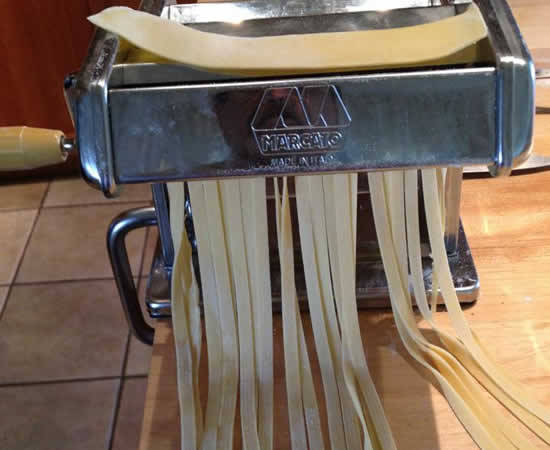
Pasta-making is one thing he really has down to a gastronomic science. He bought me the pasta maker years ago and I think I may have used it twice. He is the pasta king. He does it so well and so fast, there is just no reason for me to learn it. I concede to the master!
I had a veal, beef, pork combo that I planned to make into a meatloaf. Victor used it to make his meatballs.
Yum.
As I've said before on numerous other pasta dinners, there is no recipe for the sauce. It just is. It's very consistent, yet it can vary depending upon the meats used. It's always wonderful.
I know that's difficult for some folks to understand - they need a recipe with step-by-step instructions and exact measurements of every ingredient. But that's just not how it's done.
My contribution to dinner tonight was a loaf of bread.
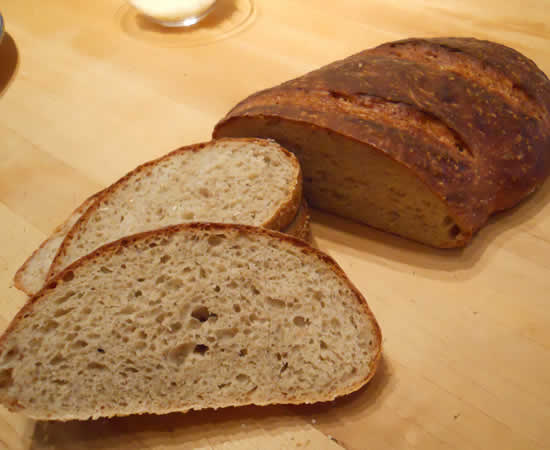
I've been making this bread for such a long time now, I have it memorized.
- 5 1/2 cups flour
- 1/2 cup rye flour
- 1/2 cup buckwheat flour
- 1 1/2 tbsp yeast
- 1 1/2 tbsp salt
- 3 cups water
Mix all ingredients, cover, and let rise three hours. At this point you can punch it down and refrigerate.
When ready to bake bread, cut off 1/3 of the dough and form into a loaf or ball. Place on cornmeal-sprinkled baking sheet or bread peel. Let rise 30 minutes. Cut deep slits into dough with very sharp knife.
Preheat oven to 450° with pizza stone on middle rack and rimmed sheet pan on bottom rack.
Slide dough onto hot pizza stone and immediately add 1 cup of hot water to sheet pan.
Quickly close oven and bake for 25 to 30 minutes.
The other nice thing about Sunday Dinner is we generally eat early. That means we get to have dessert early - and there's plenty of Victor's pound cake left from yesterday.
I ♥ Sunday Dinner
Squid Ink Pasta with Truffle Butter
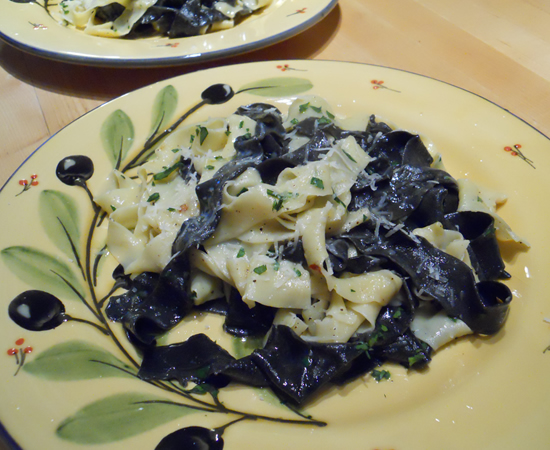
You just know that dinner was a success when, after completely cleaning your plate, you're standing over the skillet sopping up the last remnants of the truffle butter with thick slices of bread.
Welcome to my fabulous dinner!
When Victor was in London last week, he brought me home some goodies from Carluccio's. Carluccio's is a chain of Italian restaurants and shops in the UK with a dozen or so in the greater London area. One of the goodies was a jar of Burro al Tartufo - Truffle Butter. I've been looking at it in the cabinet all week, trying to think of what I wanted to make with it. It came to me last night. I didn't want to make anything with it - I wanted Victor to make homemade pasta and use it.
And he did.
Not only did he make homemade pasta, he made half of it with squid ink. I have died and gone to gastronomic heaven!
This was just one of the most fun - and delicious - dinners I've had in a while. The sauce was simple - the melted Truffle Butter with a pinch of crushed red pepper, a sprinkling of parsley, and a shred of pecorino romano.
The pasta was amazing. Victor has the pasta-making down to a science. I don't think I will ever make it, because he does it so well in such a short amount of time. It is just perfect.
The basic recipe is:
- 2 cups unbleached all-purpose flour
- 2 large eggs
- 2 large egg yolks
- up to 1 tablespoon water, if necessary
Instructions
On a clean work surface, mound flour and form a well in the center. Add egg and egg yolk to the well. Using a fork, gently break up yolks and slowly incorporate flour from inside rim of well. Continue until liquid is absorbed, then knead for 10 minutes. Wrap dough tightly in plastic and let rest for 30 minutes.
Divide dough into 3 pieces. Cover 2 pieces with plastic wrap. Flatten remaining dough piece so that it will fit through the rollers of a pasta machine.
Set rollers of pasta machine at the widest setting, then feed pasta through rollers 3 or 4 times, folding and turning pasta until it is smooth and the width of the machine.
Roll pasta through machine, decreasing the setting, one notch at a time (do not fold or turn pasta), until pasta sheet is scant 1/16 inch thick.
Cut sheet in half widthwise; dust both sides of sheets with flour. Layer sheets between floured pieces of parchment or wax paper. Cover with paper and repeat with remaining dough.
With the short end of 1 pasta sheet facing you, loosely fold up sheet, folding sheet over two or three times from short ends toward the center. With a large chefs knife, cut folded sheet into ribbons, a scant 1/4 inch wide. Unroll strips and lightly dust with flour; spread on a lightly floured baking sheet. Repeat with remaining pasta sheets.
To cook the tagliatelle, bring a large pot of salted water to a boil. Add pasta and cook until tender, about 3 minutes. Drain pasta, transfer to a large serving bowl and toss with sauce.
Victor took half of the recipe and added about a half-teaspoon of squid ink and kneaded it in. It stained his hands and the counter, but washed up quickly with a bit of soap and water.
After cooking and draining, he tossed it into the skillet with the truffle butter and mixed everything well.
After it was plated, he added just a sprinkling more of parsley and cheese.
I want him to go back to London and buy more of this stuff!
Then, again... we are heading to Italy in June... I wonder what the limit is for bringing foodstuffs back into the country... And I wonder how much I can have shipped...
Tagliatelle Fresche and Fresh-Baked Bread
It's another Saturday and I came home to another feast! Homemade pasta and homemade bread. It just doesn't get any better!
The pasta was Victor's famous tagliatelle. The bread was from James Beard.
The pasta is so light but so full of flavor and texture. It can withstand any type of sauce, but I just love it when Victor grabs whatever out of the 'fridge and creates! Tonight he took olive oil, sun-dried tomatoes in oil, oyster mushrooms, bell pepper, peas, and prosciutto, sauteed it all and then stirred in the cooked pasta and sprinkled some freshly-grated cheese on top.
Did I mention perfection?!?
Perfection.
This is a half-batch of the pasta recipe.
Tagliatelle Fresche
Ingredients
- 1 cup unbleached all-purpose flour
- 1 large egg
- 1 large egg yolk
- Coarse sea salt
Instructions
On a clean work surface, mound flour and form a well in the center. Add egg and egg yolk to the well. Using a fork, gently break up yolks and slowly incorporate flour from inside rim of well. Continue until liquid is absorbed, then knead for 10 minutes. Wrap dough tightly in plastic and let rest for 30 minutes.
Divide dough into 3 pieces. Cover 2 pieces with plastic wrap. Flatten remaining dough piece so that it will fit through the rollers of a pasta machine.
Set rollers of pasta machine at the widest setting, then feed pasta through rollers 3 or 4 times, folding and turning pasta until it is smooth and the width of the machine.
Roll pasta through machine, decreasing the setting, one notch at a time (do not fold or turn pasta), until pasta sheet is scant 1/16 inch thick.
Cut sheet in half widthwise; dust both sides of sheets with flour. Layer sheets between floured pieces of parchment or wax paper. Cover with paper and repeat with remaining dough.
With the short end of 1 pasta sheet facing you, loosely fold up sheet, folding sheet over two or three times from short ends toward the center. With a large chefs knife, cut folded sheet into ribbons, a scant 1/4 inch wide. Unroll strips and lightly dust with flour; spread on a lightly floured baking sheet. Repeat with remaining pasta sheets.
To cook the tagliatelle, bring a large pot of salted water to a boil. Add pasta and cook until tender, about 3 minutes. Drain pasta, transfer to a large serving bowl and toss with sauce.
And then, just because perfect pasta wasn't enough, he made a loaf of one of my favoriote breads!
This comes from the Beard on Bread cook book by James Beard. It's quick and reasonably difficult to screw up!
James Beard French-Style Bread
- 1 1/2 pk active dry yeast
- 1 tbsp sugar
- 2 cups warm water (100-115 deg.)
- 1 tbsp salt
- 5-6 cups all-purpose or hard wheat flour
- 3 tbsp Yellow cornmeal
- 1 egg white mixed with 1 tbsp cold water
Combine the yeast with sugar and warm water in a large bowl and allow to proof. Mix the salt with the flour and add to the yeast mixture, a cup at a time, until you have a stiff dough.
Remove to a lightly floured board and knead until no longer sticky, about 10 minutes, adding flour as necessary.
Place in a buttered bowl and turn to coat the surface with butter. Cover and let rise in a warm place until doubled in bulk..1 1/2-2 hrs.
Punch down the dough. Turn out on a floured board and shape into two long, French bread-style loaves. Place on a baking sheet that has been sprinkled with the cornmeal, but NOT buttered.
Slash the tops of the loaves diagonally in two or three places with a single edge razor blade or sharp knife, brush the loaves with the egg white wash.
Place in a COLD oven, set the temperature at 400° and bake 35 minutes, or until well browned and hollow sounding when the tops are tapped.
The meal was perfection all the way.
Fresh Summer Pasta
It's still a gazillion degrees outside but we just had pasta - and it was heavenly!
Light, refreshing, full of the flavors of summer. Pasta.
Victor made fresh tagliatelle pasta today. It's a pasta he has seriously mastered over time. It is pure silken perfection.
And atop that pure silken perfection was an uncooked sauce comprised mostly of fresh garden produce. It was unbelievably fresh-tasting; the perfect hot-weather meal.
The tomatoes, peppers, and basil came from the yard. Fresh asparagus, garlic, and sun-dried tomatoes pretty much finished it off.
There are no measurements for the sauce. Use what you have to make as much as you need.
Salsa di Tagliatelle Fresche
- olive oil
- cherry tomatoes
- bell peppers
- roasted red and yellow peppers
- asparagus
- garlic
- sun-dried tomatoes
- fresh basil
- parmesan cheese
- salt and pepper, to taste
Cut asparagus and quickly blanche. Drain and drop into ice water immediately to stop cooking and chill.
Meanwhile, halve the cherry tomatoes and slice the peppers and place in bowl with asparagus, garlic, sun-dried tomatoes, and olive oil. Add minced fresh basil, shredded parmesan cheese, and salt and pepper, to taste.
Leave at room temperature for flavors to meld up to an hour or so.
Tagliatelle Fresche
Ingredients
- 2 cups unbleached all-purpose flour
- 2 large eggs
- 2 large egg yolks
- Coarse sea salt
Instructions
On a clean work surface, mound flour and form a well in the center. Add eggs and egg yolks to the well. Using a fork, gently break up yolks and slowly incorporate flour from inside rim of well. Continue until liquid is absorbed, then knead for 10 minutes. Wrap dough tightly in plastic and let rest for 30 minutes.
Divide dough into 3 pieces. Cover 2 pieces with plastic wrap. Flatten remaining dough piece so that it will fit through the rollers of a pasta machine.
Set rollers of pasta machine at the widest setting, then feed pasta through rollers 3 or 4 times, folding and turning pasta until it is smooth and the width of the machine.
Roll pasta through machine, decreasing the setting, one notch at a time (do not fold or turn pasta), until pasta sheet is scant 1/16 inch thick.
Cut sheet in half widthwise; dust both sides of sheets with flour. Layer sheets between floured pieces of parchment or wax paper. Cover with paper and repeat with remaining dough.
With the short end of 1 pasta sheet facing you, loosely fold up sheet, folding sheet over two or three times from short ends toward the center. With a large chefs knife, cut folded sheet into ribbons, a scant 1/4 inch wide. Unroll strips and lightly dust with flour; spread on a lightly floured baking sheet. Repeat with remaining pasta sheets.
To cook the tagliatelle, bring a large pot of salted water to a boil. Add pasta and cook until tender, about 3 minutes. Drain pasta, transfer to a large serving bowl and toss with sauce.
It really brought out the flavors of summer. I had actually been craving ravioli for the past few days but kept thinking about how heavy they can be - and I just didn't need heavy food with this weather.
This solved the ravioli craving and brought summer's bounty indoors.
I made a loaf of beer bread at the last minute just to have something to sop up the juices on the plate.
Quick Beer Bread
- 3 cups self-rising flour
- 2 tbsp sugar
- 12 oz beer
Use a 4″ x 8″ bread pan. Mix ingredients and place in buttered pan. Top with melted butter and bake at 350° about 1 hour.
There was enough of the vegetables left over to have as a salad for lunch tomorrow.
A perfect summer dinner.
Ricotta Rollatini
It is so nice being married to a man who loves to cook! As much as I like being in the kitchen, it truly is great to come home to a delicious homemade meal.
And tonight's homemade meal really was a show-stopper!
The recipe concept came from Giada De Laurentis. The result is pure Victor!
Giada's recipe is a spinach and ricotta roll that she puts under a broiler and serves with a marinara dipping sauce as an appetizer.
Victor reworked it to a baked entree. A much better idea, if ya ask me. Granted, I'm just a bit biased as I was the recipient of the entree, but... that's just the way of it!
Giada's recipe calls for the pasta to be made in a food processor. Victor made his by hand because he has totally mastered the art of pasta making. Like bread making or anything else, recipes give you quantities of ingredients, but it's the feel of the dough that makes it work. It's why your grandmother could never tell you exactly how she made a pie crust or a rolled dumpling - she just did it and knew when it was right.
Ricotta Rollatini
Pasta:
- 2 cups all-purpose flour
- 2 eggs
- 2 egg yolks
- 1/2 teaspoon kosher salt
- water, if needed
Filling:
- 4 oz diced prosciutto
- 4 cups whole milk ricotta cheese
- 1/2 cup grated Locatelli
- 2 eggs
- 1/2 minced flat-leaf parsley
- freshly ground black pepper
Make pasta.
Mound flour on counter and make well. Add eggs and yolks and gradually work in the flour to make a firm but pliable dough, adding a few drops of water, if necessary. Divide into two pieces, cover, and let rest about 30 minutes.
Make filling:
Fry prosciutto until crisp. Drain and set aside.
Mix ricotta, eggs, cheese, pepper, and parsley. Stir in cooled prosciutto. Set aside.
Roll pasta to a 15" x 7" rectangle. If you have a pasta roller, bring it through to about 15" on level three and then roll it width-wise to about 7".
Spread half of filling on pasta sheet and brush ends and edge with egg. Roll jelly-roll style and seal ends and edge.
Repeat with second roll.
Wrap each pasta log in cheesecloth and tie ends with kitchen twine.
Lower into barely-boiling water and cook for 15 minutes.
Remove from water and place on racks to cool.
Remove cheesecloth and slice each roll into 3/4" slices.
Cover bottom of baking dish with marinara sauce and lay out slices. Drizzle with marinara and sprinkle with additional grated Locatelli.
Cover with foil and bake until heated though - about 30 minutes at 350°.
Serve with additional sauce, if desired.
This is one of those creations that just works on every level. Rich, creamy, just-salty-enough from the cheese and the prosciutto. Victor didn't add any salt to the filling, at all. The pasta was perfectly al dente.
Cooking hint: If you have a fish poacher (thank you, Ruth!) it will make cooking them much easier. Victor actually forgot about it and slightly curved them to fit in a large pot. When we make these for Easter, we'll be using the poacher, for sure!
Spicy Italian sausage went well with these, but it was actually a bit of over-kill. They weren't necessary. The pasta was so good, they were almost a distraction.
I can't wait to have this one, again!
Ravioli del Formaggio Cinque
This is a platter of homemade 5-cheese ravioli in a sauce of speck, sun-dried tomatoes, and langostino. I can't even begin to describe how happy my tummy is right now. My taste-buds have been doing cartwheels for 45 minutes.
I am one happy dude. I can't believe it isn't soup.
A couple of weeks ago Victor said he wanted to make ravioli. I, of course, immediately stated it was a fantastic idea and I was ready to eat them the moment he made them.
And then I caught a cold, he had to go to Chicago on business...
But today, while I was toiling away at work, he did his magic.
And magic, it was.
Clouds of cheese-filled heaven in a sea of tomatoes. It amazes me how he can make something so rich and so filling - and so light at the same time. It really is magic.
Ravioli del Formaggio Cinque
Dough
- 2 cups all-purpose flour
- 3 eggs
- 1/4 tsp salt
- 1/4 tsp olive oil
Make a mound of the flour on a counter. Make a well and add the eggs, oil, and salt. With your fingers, slowly incorporate the flour into the liquid.
Knead the dough until it is smooth and elastic, about 10 minutes. It should feel silken and smooth.
Cover and let rest about 30 minutes.
Cut dough into three pieces and roll through pasta rollerfolding and refolding the first few times as it gets thinner. Continue rolling to the 7th setting.
Filling
- 1 lb ricotta
- 1 cup shredded cheeses (Victor used fontina, assiago, parmesan, and provelone)
- 1 egg
- 2 tbsp minced parsley
- 1 tsp garlic powder
- salt and pepper, to taste
Mix all ingredients.
To assemble
Lay out one strip of dough on counter and place heaping tablespoons of filling about every three inches just to the left of center.
Fold dough over. Use biscuit or other cutter to cut ravioli. Crimp edges with times of fork.
Lay out on lightly-floured sheet pans and cover with kitchen towels until ready to cook.
To cook
Bring salted water to a just-barely boil in large, shallow braiser or skillet. Add ravioli a few at a time and cook about 3-4 minutes, or until done. Do not hard boil as they will fall apart.
Drain and serve with your favorite sauce.
The favorite sauce tonight was, as mentioned earlier, a simple tomato sauce with speck - a type of prosciutto - sun-dried tomatoes, and langostino.
The red sauce worked fabulously with the ravioli, but I think just about any sauce would work, from a butter and walnut or sage to a light vodka sauce.
The ravioli will stand up to anything!
We're doing Easter this year for the family and I'm thinking these would be a perfect accompaniment to whatever we're serving.

